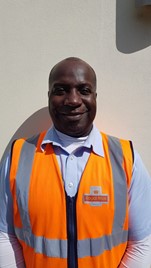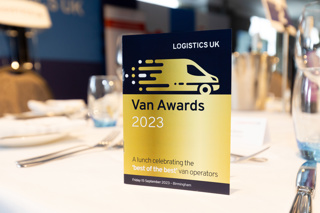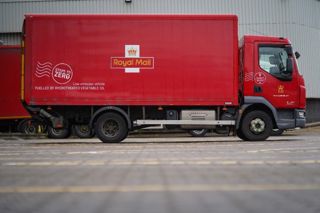
This article originally appeared in the May issue of Fleet News available as a digital edition.
With an uplift in parcels as consumers turn to online shopping during the coronavirus lockdown and a shift from van sharing to one person/one van, Royal Mail’s fleet director Paul Gatti (pictured) explains how he and his team have adapted to support the operation and keep staff safe. As told to Sarah Tooze.
9am: Conference call with workshop team
I have been working from home since this all began and my day is spent making and taking conference calls. Every morning I have a call with the workshop team, which is led by Sally (Warren), my head of maintenance.
Everyone gives a score out of 10 for tiredness and a score out of 10 for morale. As you can imagine, it ebbs and flows dependent on the day, but it’s always good to keep a record of those numbers. If someone is feeling low, we make sure we rally round and they get a few calls of support during that day from Sally and myself.
During the conference call, each workshop manager talks about coronavirus-related absences. We have 110 workshops and around 1,000 technicians and we need to understand which units are being challenged the most. We also discuss the changes we have made in the workshops and will refine them if necessary.
We have introduced a lot of additional preventive measures. We maintain strict social distancing rules in all our workshops in line with company policy.
When we get a vehicle in it needs to be cleaned and disinfected before we start working on it. When the keys are handed over, they are also cleaned and disinfected before they are hung up. Every tool that is shared needs to be cleaned after use, and even for things like allocating parts from the storeroom, we have created a process for social distancing.
In line with the guidance from public health authorities, good hand hygiene is still one of the most important lines of protection, coupled with enforcing a strict two-metre social distancing rule. We have markers on the floor in our reception areas to maintain that distance.
We’ve introduced staggered break times so, whereas before, you might have had six people in a restroom at one time, now you only have two. We’ve also introduced staggered work times so we don’t have everyone arriving at the same time.
Our other key focus, of course, remains making sure the operation has as many vehicles as it needs to manage this busy time. Our letter volumes have gone down, but parcels have increased significantly so the operation is busier than normal at this time of year.
We have implemented a new policy of one person in a van as part of a range of social distancing preventive measures. Normally, we have two people going out in a van, they stop in a street, both jump out, take some mail, do a loop with that mail, get back in and drive to the next point. But that’s not possible with the two-metre rule.
To support the operation, we’re making greater use of our fleet of mobile technicians allowing us to provide more on-site service rather than the operator having to bring the vehicles back into the workshop.
To ensure that we identify any vehicles in the operation that might have a fault, we carry out a check every day and any faults are highlighted to the manager. This gets relayed to the workshop and then we fix it. We also deploy technicians to carry out walkaround checks of the vehicles that are in the yard.
10am: Conference call with managers across the business
These are weekly conference calls with managers to talk about what is happening in the organisation in terms of responding to Covid-19. Then there are ‘questions from the floor’.
10am: Conference call with managers from fleet
Every fortnight I lead a call with all the managers from fleet, which is around 120 managers. It’s a ‘state of the nation’ across fleet. I give an overview of what has changed and talk about any challenges.
It’s important we talk about how our own business unit is responding to demand because there are a lot of operational calls about processing and moving mail. This call is all about how we best support the operation. It also allows people to raise any questions with the fleet management team.
Some non-operational-facing colleagues are working from home and could feel isolated. We always make sure we point them to the company resources around how to ensure their wellbeing.
But the biggest part of the call is saying ‘thank you’ for all the hard work and support our people give as we play an important role in keeping the UK connected.
Noon: Supplier update
We have a spreadsheet with all of our fixed supply chain listed and what the status of each is – either red, amber or green and the latest update we’ve had from them. Looking at our supply chain now, it’s thankfully pretty much ‘green’ across the board.
It was a different picture a month ago. The immediate response was to close, to scale right back, but we’re finding most of our suppliers have got their head round some of the challenges and have started to re-open.
We have appointed a specialist company to clean any vehicles that may have been contaminated on those rare occasions when a driver may be taken ill. So, if a driver has been found to have the coronavirus, that vehicle is quarantined for 72 hours before being given a full clean by the specialist contractor.
1pm: Conference call with direct reports
I have a call every day with my direct reports and I also have one-to-ones. My diary is starting to fill up with end-of-year appraisals. I also have a weekly meeting with my boss and his direct reports.
3.30pm: Conference call with the union
I touch base with the union that represents the fleet team regularly to get feedback from them about any concerns that may be coming through from people on the ground.
4pm: Conference calls about projects
We’re deploying a number of ‘business as usual’ initiatives so I have a weekly touchpoint with my team and the same with the central programme team on what we’re doing.
Some projects have been paused while other things have been accelerated.
We’ve learned a lot from Covid-19 in terms of how you can do things differently. So, we’re picking up some of those learning points and applying them to other scenarios as we move into the new normal.
Frontline fleets: Case studies
Andrew Philips, postal worker at Royal Mail 
Andrew Philips, a postman based in Kenton, London, has had to adapt to a new way of working having van shared with a colleague for the past eight years.
Instead of collecting mail together from the local office, Philips now travels there alone.
“I go in a bit early, about 6am, to start prepping up both deliveries so we can get it all out and completed within the duty time,” he says.
“When I’m ready to leave I call my delivery ‘partner’ to say I’m on my way and he makes his way to the drop point.”
Before Philips leaves the office, he carries out his usual vehicle walkaround checks and cleans the van using a sanitiser spray, making sure all the touchpoints such as the door handles, steering wheel and gear knob are cleaned. He also cleans it at the end of the shift in case the van needs to be used by one of the collection drivers.
“We’ve been given hand sanitisers, masks and gloves to make sure we’re properly protected,” Philips says.
When he meets his colleague at the drop point they maintain social distancing.
Philips adds: “He works from the drop point. He loads up his trolley, does one loop, comes back to the drop point, loads up again and goes off again whereas I do my deliveries from the van. I park it up, do a loop, move the van, do another loop,” he says.
Social distancing is being maintained with customers too.
“We’re no longer handing over our PDAs (postal digital assistants) to the customer to sign for a delivery,” Philips says. “Now we knock on the door, leave the parcel on the doorstep, step back, and when the customer opens the door to pick the parcel up, we put in a code to confirm it’s been delivered, so we’re protecting ourselves and the public.”
Philips has been a postman for 32 years and has never experienced such major change, but recognises it is a necessity.
“Obviously people’s health comes first,” he says. “It’s a situation where people have to adapt. You’ve got to try to stay healthy, stay safe.
“We’re just carrying on, doing the best we can, and, hopefully, we can get through it and come out the other end smiling.”
You can read the article in the May issue of Fleet News, by clicking here
Tomorrow's frontline fleets explores how Justin Wand, director - strategic assets and property at London Ambulance Service (LAS) is handling significant challenges with logistics, vehicle preparation, supply and maintenance at the UK epicentre of the pandemic.
Keep up to date with Covid-19 news and guidance
For the latest commercial fleet guidance on Covid-19, click here
For the latest commercial fleet-specific Covid-19 news, click here
The FTA and CILT have launched a coronavirus good practice guide, access it here


















Login to comment
Comments
No comments have been made yet.